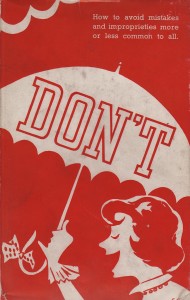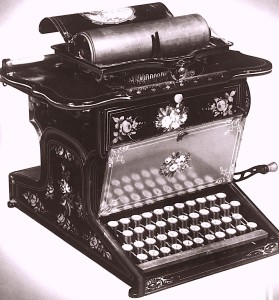 Books on social etiquette have always proved popular. People are naturally curious about the manners of other ages. Such books also produce good talking points at parties or other social events. Don’t, a copy of which was recently discovered at Jot HQ, purports to deal ‘ frankly with mistakes and improprieties more or less common to all ‘, is no exception. Although undated, the dust jacket illustration and general design places it firmly in the early fifties, and an AA leaflet dated August 1953, which has been tucked into it, confirms this guess.
Books on social etiquette have always proved popular. People are naturally curious about the manners of other ages. Such books also produce good talking points at parties or other social events. Don’t, a copy of which was recently discovered at Jot HQ, purports to deal ‘ frankly with mistakes and improprieties more or less common to all ‘, is no exception. Although undated, the dust jacket illustration and general design places it firmly in the early fifties, and an AA leaflet dated August 1953, which has been tucked into it, confirms this guess.
‘Censor’, the pseudonymous author of Don’tmakes no apologies for the book’s distinctly proscriptive tone. ‘ Manners maketh man ‘, he/she quotes, adding rather severely that if the rules appear ‘ over-nice’, ‘ everyone has the right to determine for himself at what point below the highest point he is content to let his social culture drop’. Ouch!
Reading certain parts of this book will make most people cry out in protest at an unreasonable ‘don’t’. For instance, why shouldn’t people wear jewellery that is ‘ solely ornamental’. What’s the point of jewellery unless it is ornamental ? Then there’s the request not to drink outside of meal times. Does this mean that one shouldn’t drink in pubs, hotels or at parties? Obviously absurd. ‘Censor’ is equally unreasonable concerning the shaking of hands: ‘Don’t …offer to shake hands with a lady. The initiative must always come from her. By the same principle DON’T offer your hands to a person older than yourself, or to anyone whose rank may be supposed to be higher than your own, unless he has extended his.’ Totally irrational. Then there is the faux gallantry: ‘Don’t forget that the lady sitting at your side has the first claim upon your attention. A lady at your side should not be neglected, whether you have been introduced to her or not.’ Even in 1953, this must have appeared preposterous, although another ‘don’t’—that men must not remaining sitting when a lady leaves the table —was still observed in some circles. Continue reading


